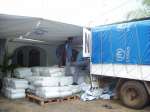UNHCR chief visits emergency transit centre in Romania
News Stories, 28 May 2010
BUCHAREST, Romania, May 28 (UNHCR) – UN High Commissioner for Refugees António Guterres has visited Europe's first emergency transit centre (ETC) in Romania, meeting Sri Lankan and Palestinian refugees.
The emergency transit centre was opened in the city of Timisoara in late 2008 by the Romanian government, UNHCR and the International Organization for Migration (IOM). It's formal launch was in March 2009.
It provides a temporary haven for refugees in urgent need of evacuation from their first asylum countries due to life-threatening conditions. They can stay for up to six months before being resettled in third countries. A second transit centre was opened in Slovakia last July.
Guterres, who is on a two-day visit to Romania, visited the ETC on Thursday and met some of the 152 refugees of Palestinian and Sri Lankan origin currently staying there and awaiting resettlement. One group of 99 had arrived at the centre earlier this week after an exhausting 26-hour journey to Romania from the desert camp of Al-Walid in Iraq, where they had spent years.
"This is a pioneering project which answers to a clear need shown by the Uzbek operation," Guterres said, referring to Romania's agreement in July 2005 to temporarily shelter 439 Uzbek refugees airlifted from Kyrgyzstan and eventually resettled. The operation helped pave the way for the establishment of the ETC.
"UNHCR was in need then, and you see who your friends are in times of need. I want to express my deepest appreciation to the Romanian government and people for hosting this emergency transit centre," said Guterres, who also planted a "tree of wishes" in the centre.
Among those at the centre, was an 80-year-old Palestinian man from Iraq whose energy belied his age. He said he craved stability. "I want any citizenship, just so I can visit my sons and daughters, scattered all over the world," he said.
A young Sri Lankan woman said she was forced from her home during the long struggle that ended last year between government forces and the Liberation Tigers of Tamil Eelam. She made her way to India, Singapore and Indonesia before being flown to Romania. "Even though I hadn't heard of Romania before, I really like it here. I feel really good," she said.
More than 600 refugees have transited the ETC in Timisoara since it opened in 2008, the same year that Romania passed legislation making it one of the few countries ready to accept refugees for resettlement. A first group of refugees from Myanmar is expected to arrive in the country from Malaysia in early June.
In Bucharest on Friday, the High Commisioner held talks with top officials, including Romanian Prime Minister Emil Boc.
By Claudia Liute in Bucharest, Romania












































